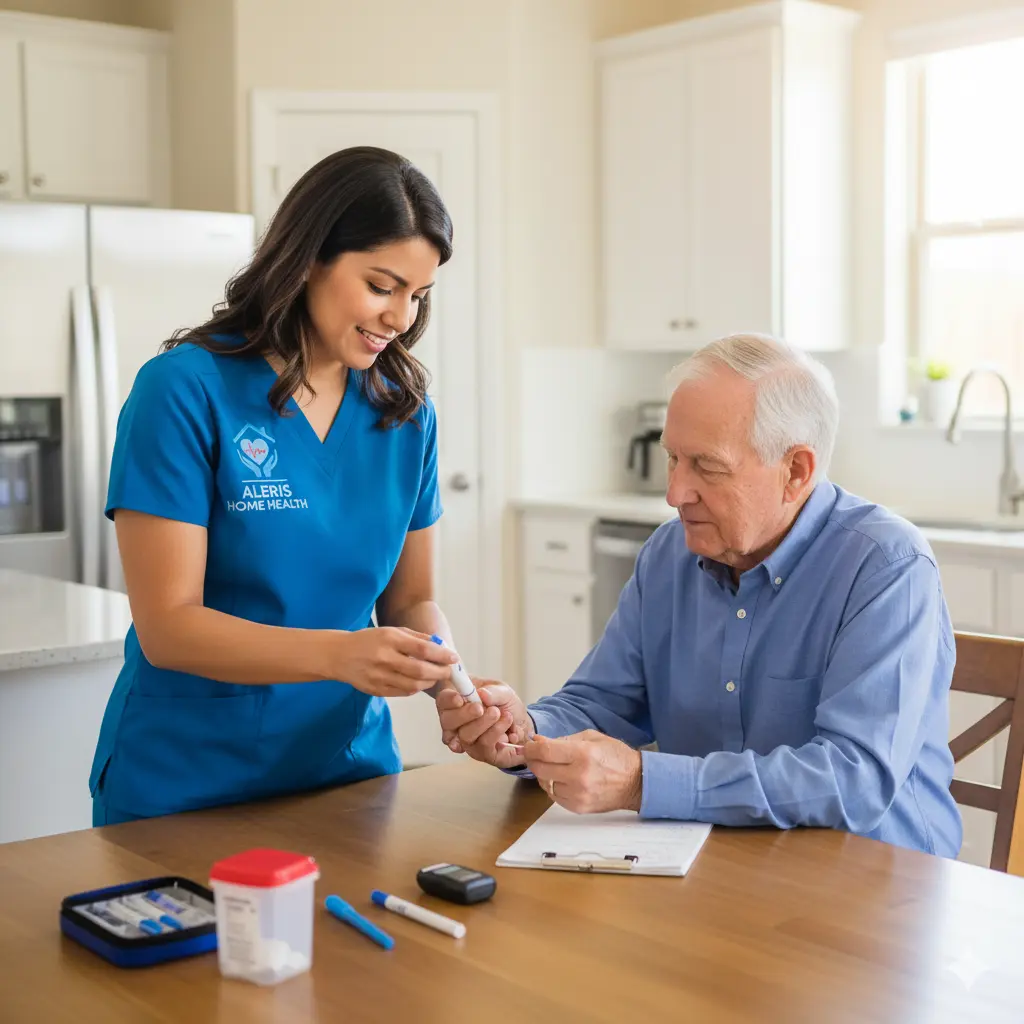
Home Care Tips for Diabetic Patients: What Families Should Know
Author: Alan Jacob, Medical Writer • Service area: Sugar Land, Houston & surrounding communities
Quick answer: If you’re learning how to care for a diabetic patient at home, build a daily routine for blood sugar checks, on-time medicines/insulin, balanced meals, hydration, activity, foot/skin checks, and a sick-day plan—personalized by the clinician. This is the core of strong diabetes care at home.
What Diabetes Care at Home Includes
- Glucometer setup, testing schedule, and a simple paper/digital log.
- Medication/insulin timing, site-rotation chart, and sharps disposal.
- Meal template using the plate method, carb awareness, and hydration.
- Hypoglycemia kit with a clear step-by-step low-sugar protocol.
- Diabetic wound care at home: cleanse, dress, offload, and when to escalate.
- Daily foot checks (skin, nails, temperature, sensation) with protective footwear.
- Activity plan adapted to mobility and other conditions.
- Sick-day rules and who to call for urgent changes.
Who Qualifies—And When Home Diabetes Care Is Right
Choose home diabetes support when a patient needs help with insulin, vision-limited testing, cognitive support, a new regimen (e.g., basal-bolus), or device training. It’s especially helpful if sugars swing widely, there are recurrent lows/highs, or a new foot ulcer.
Not appropriate: suspected DKA, altered mental status, uncontrolled infection, or rapidly worsening ulcers—call 911 or go to the ER. Always follow the prescribing clinician’s plan.
If you’re comparing local options, here’s what to look for when choosing a home care agency so you get the right oversight and visit types.
Key Benefits of Diabetes Care at Home
- Fewer ER visits by catching issues early with daily checks.
- More time in range through consistent testing and dose timing.
- Faster healing with correct dressings and offloading for wounds.
- Higher caregiver confidence thanks to written protocols.
How It Works — Step by Step
- Organize: One-page plan—test times, insulin/meds, meals, activity, foot/wound checks.
- Execute: Follow the plan, log results, use the hypoglycemia protocol when needed.
- Review: Share logs weekly with the clinician or home-health nurse and adjust.
Daily Home Routine for Diabetes Care at Home
Test & Record: Check fasting and any additional times your clinician recommends. Keep meters clean and use control solution as directed. Medications/Insulin: Take on time; rotate injection or CGM sites; store insulin properly; never reuse needles. Meals: Use the plate method (½ non-starchy veg, ¼ lean protein, ¼ smart carbs); hydrate; limit sugary drinks.
Activity: Light movement after meals unless contraindicated. Foot & Skin: Inspect daily with a mirror for color, cuts, calluses, or warmth. Moisturize (not between toes). Wear cushioned footwear. Need clarity on duties? See caregiver duties and responsibilities to structure safe support at home.
Wounds: For diabetic wound care at home, cleanse as ordered, apply the right dressing, offload pressure, and document size/appearance. Escalate signs of infection. Many families also ask what’s covered—review what Medicare covers for home health to plan dressing changes and nurse visits.
Hypoglycemia (often <70 mg/dL; follow your target): Take 15g fast carb (glucose tabs/juice), recheck in 15 minutes, repeat if still low, then have a snack/meal. For general education, the CDC diabetes resources explain testing, nutrition, and risk reduction.
Reminder: This page shows you how to care for a diabetic patient at home, but always personalize steps with your clinician.
Mini Case Studies / Testimonials
“Mom’s sugars used to swing.” After two weeks with set testing times, mealtime walks, and site rotation, her time-in-range improved from ~45% to ~70% and there were no ER trips that month.
“Foot sore wouldn’t close.” With offloading, correct dressing, and weekly nurse checks, the ulcer reduced by ~60% in 4 weeks and infection signs resolved.
FAQs: How to Care for a Diabetic Patient at Home
How often should we check blood sugar at home?
Follow your clinician’s schedule. Common patterns include fasting, before meals, and at bedtime; increase during illness, regimen changes, or symptoms.
What’s a good target range?
Targets are individualized. Many adults aim ~80–130 mg/dL before meals and <180 mg/dL after, but follow your provider’s targets.
Which carbs are best?
Favor fiber-rich carbs (whole grains, beans, fruit, dairy, vegetables). Pair carbs with protein and healthy fats to blunt spikes.
How do we do diabetic wound care at home safely?
Cleanse as ordered, apply the right dressing, keep pressure off, monitor edges/odor/drainage, and escalate fever, spreading redness, or pain.
When do we call 911?
Severe low sugar with unconsciousness, chest pain, trouble breathing, or rapidly spreading infection warrants emergency care.
Can home-health nurses help with insulin and CGM?
Yes. Nurses can train on injections, site rotation, CGM use, and documentation that supports your provider’s plan.
Need Local Help in Sugar Land & Houston?
Call (281) 313-0087 or book a nurse visit within 24–48 hours.
Safety note: Educational content only; not a substitute for medical advice. Follow your clinician’s individualized plan.
!– JSON-LD SCHEMA (paste as-is in a Custom HTML block OR your SEO plugin’s custom schema for THIS PAGE only) –>